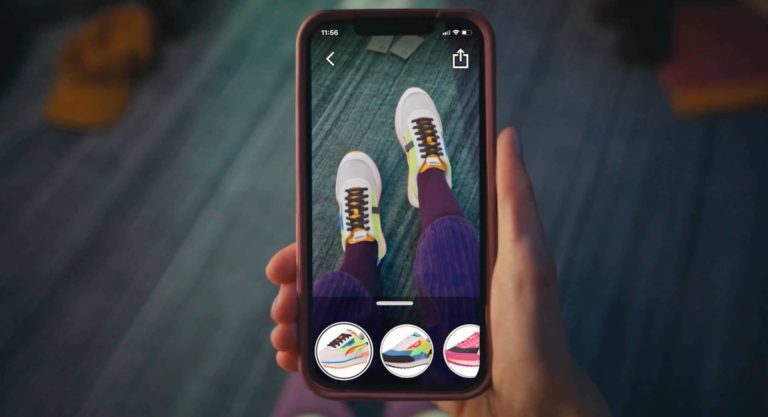
Augmented reality continues to offer opportunities for businesses to level up. ARtillery Intelligence projects AR revenues to reach $39 billion by 2027. This change could revolutionize business by enhancing emotional connection and deepening engagement in brand marketing.
That list includes many aspects of life and work, but an area primed for AR disruption is advertising. How can it transform this longstanding industry and its practices? Let’s take a look.
AR in 2023: What Do We Know So Far?
The AR industry has developed considerably in recent years on hardware and software fronts. It’s also seen increased adoption across business verticals and use cases, as well as integrations with other emerging tech like AI and IoT. These integrations have not only expanded AR’s value but made it more accessible and applicable to various business interests and stakeholders.
Several of these businesses have begun to recognize AR’s value and potential when implemented in their workflows. And one of the traits of this transformation has been its breadth, finding soil across healthcare, education, retail, and manufacturing sectors. Educators are using AR to enhance traditional learning and medical professionals are using interactive visuals powered by AR to improve patient diagnosis and treatment.
Another exciting trend, as noted, is AR in advertising, creating an interactive and engaging experience for users to try products virtually or interact with specific brand experiences.
Interactive Advertising
Advertising surrounds us for better or worse. Brands now see AR as a means to differentiate their brand messaging, given that the field has operated in two dimensions since its inception. AR conversely lets users interact with products dimensionally. And this can be done with a certain degree of versatility given that AR marketing formats continue to develop across social media, mobile apps, and websites. Increasingly, they can be activated by familiar markers, such as QR codes.
AR product try-ons are one way this is playing out, as noted. By incorporating AR in product demonstrations, companies allow potential customers to see and interact with products in the virtual environment before purchasing. For instance, a furniture brand such as IKEA enables customers to fit furniture in their homes to see if the style and design match their tastes.
Beauty brands meanwhile show how virtual makeup would look on the end user’s face. Gucci’s “Try On” campaign allowed users to try the sneakers on their feet. Automotive brands can also deliver digital twins of their cars. “You could walk around it, tap to open doors, and even play with the gadgets inside. This reality is not far off,” noted Bernard May for Forbes.
Taking this a step further, game mechanics can infuse greater levels of interactivity. For example, a food brand can create an AR game where users could catch products falling from the sky, similar to the movie “Cloudy with a Chance of Meatballs.”
In all these examples, AR advertising has the potential for virality, with users sharing experiences on social media. This leads to increased brand exposure and a wider reach. Finally, AR’s immersive nature leads to higher campaign performance including key metrics like brand recall (upper funnel), and higher conversion rates (lower funnel). After all, shoppers buy with their eyes.
Not All Good News…
While the world enhanced with AR can be captivating, ads often face challenges, When creating AR ads, developers often struggle with technical challenges as it’s technically complex. For example, developers must ensure that ads run smoothly across platforms, whether mobile or desktop.
Another challenge is cost. For all the reasons above regarding technical complexity, it requires talent, which can be expensive. For small businesses with limited budgets, producing effective AR marketing can be cost-prohibitive.
Another hurdle is user adoption. Consumers that are familiar with and comfortable using AR are relatively limited in number. As a brand, you must apply lots of rigor to ensure campaigns are user-friendly and accessible to a broad audience.
Analytics can also pose a challenge, as traditional metrics such as clicks and views don’t always capture the depth of engagement AR is capable of. That’s why it is crucial to develop effective measurement and analytics to better grasp how campaigns perform and to improve them over time.
Looking Forward
Despite the above challenges, AR holds worthwhile potential in advertising and marketing. As technology advances, AR will be more accessible to a broader audience, giving brands more potential for reach and impact. There will also be opportunities for campaigns that are personalized and targeted to deliberate audiences. The latter will improve as AR’s aforementioned analytics issues are ironed out. As that advances, brand marketers will better understand their audiences and optimize campaigns accordingly.
Meanwhile, various flavors of AR advertising will continue to expand beyond sponsored AR lenses and product try-ons. For example, AR could allow brands to integrate digital product placement dynamically into movies and TV shows. This is already developing today from companies like Innovid. One logistical and operational benefit this brings is targeted product placement that’s placed dynamically without reshooting scenes. Additionally, these experiences can prompt audiences to go deeper with AR in their own space through interactive ‘second screen’ experiences.
Altogether virtual product placement could revolutionize the advertising industry by offering new ways to engage with customers and amplify product visibility. With that and other developments, AR has the potential to transform how we see and experience advertising.
 Vitaly Gerko is co-founder and CPO of AdTech platform OTM.
Vitaly Gerko is co-founder and CPO of AdTech platform OTM.






